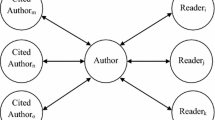Abstract
Interpretation of literary texts is a multidimensional task requiring students to master a variety of skills and to acquire factual knowledge in diverse areas. The use of the World Wide Web in conjunction with student computer accounts has allowed me to create a virtual classroom in which students can explore many historical and theoretical aspects of interpretation through the use of HTML tutorials and Web resources. The discussion of the literary text in a community of scholars can take center stage in the physical classroom.
Similar content being viewed by others
Author information
Authors and Affiliations
Additional information
Charles T. Davis, III is Professor of Philosophy and Religion at Appalachian State University where he teaches and engages in research in New Testament Studies. He is the author of “Confession and Canon,” Perspectives on Witness and Translation: Essays in Honor of John E. Steely, The Edwin Mellan Press, 1993 and Speaking of Jesus, CSA Press, 1978.




